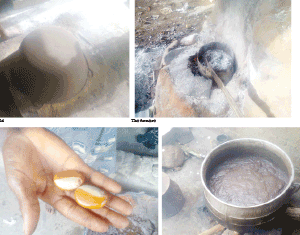Making aluminium pots, commonly called ikoko irin (iron pots) by the Yoruba, is one of the major occupations of the people of Saki in Oyo State.
Saki boasts a large number of craftsmen who belong to the Aluminium Potters Association (APA) that controls the profession.
 Ikoko irin is used for a variety of purposes, such as cooking, drinking, and flower vases. They vary in shapes and sizes. The production can take up to an hour, depending on the materials and the skill of the craftsman.
Ikoko irin is used for a variety of purposes, such as cooking, drinking, and flower vases. They vary in shapes and sizes. The production can take up to an hour, depending on the materials and the skill of the craftsman.
The size of the pots varies from one to 20. One costs between N3,000 and N5,000 depending on the size.
A craftsman, Taofeek Adedipe, said apprenticeship lasts between two and five years, after which a graduate is at liberty to continue with his trainer on contract or break out on his own.
He explained that a mould is made with the cast of the pot and afterwards the molten metal is poured into the cast to solidify.
Another craftsman, who simply gave his name as Jaiye, said it takes one and a half hours to make a pot. If well maintained, an ikoko irin can last up to six years.
Implements
The materials used in the production are aluminium metals and scraps of worn-out engines. Aluminium is a good transmitter or conductor of heat, hence its durability. But not all kinds of aluminium are good conductors of heat.
The moulds used for casting is loamy sand, which is a mixture of sand and clay.
Another important material is charcoal, which produces heat to melt aluminium metals.
Other implements include
• Crucible. A metal container for melting scrap metals in the furnace.
• Melting furnace. An enclosed place where melting is carried out. Primarily made of clay. Called oju aro in Yoruba.
• Racks. Wooden beam, usually rectangular, used as a support guide for a mould. Of different sizes, depending on pot size.
• Shovel, hoe, tongs. Shovel and hoe used for filling sand; tongs, a grasping tool, used to transfer and pour melted metal from the furnace into the mould.
• Spoon. For smoothening moulds and labelling pots.
Ikoko irin production process
There are two processes of making ikoko irin: moulding and casting.
Moulding is internal, casting is external.
The first step is to fashion the prototype of the pattern of the pot to be used, depending on the choice of the buyer or the craftsman.
Moulding is the most fundamental part of the process, because it helps to create the interior of the pot.
The next step is to set up the bed. This is done by spreading the sand on the space required.
The patterns of a pot may be halved or used whole, after which sand is poured in and tightened to harden the sand like stone. The craftsman scoops the middle area of the mould to make a hollow portion.
Making the exterior is highly specialised, requiring the skill and expertise of the craftsman. At this stage, the wooden racks are required for the outer mould, depending on the size of the pot or type of cast.
Wooden racks are placed around the model pot and must be in proportion. Sand is introduced and moulding begins.
While the sand mould is being prepared, the materials used for casting are heated in the crucible (a cup shaped piece and heat-resistant container) on the furnace.
When the melting is ready, unwanted materials in the molten metal are removed. The molten metal is ready when its colour changes to orange.
The final step is pouring the molten metal through the hollow part created on the moulds and allowing it to cool. The moulds are broken to reveal the cast ware – and voila, the aluminium pot is made.
The quality and originality of an ikoko irin depends on the type of metal used for the casting, whether it is thick or light, and whether the metals are in their right proportions, because not all aluminium materials are good conductors of heat.
Ikoko irin is adjudged to be original when the interior and exterior have a silvery and whitish colour. They are widely used in Nigeria and exported to Benin Republic, Togo, Cote d’Ivoire, and Ghana.
Shea butter
In Igboho, a border town with Saki, locals produce shea butter, popularly known as ori, a household name in the South West.
Shea butter is solid fat obtained from the seeds of shea tree nuts. The botanical name of the tree is vittelaria paradoxia. It grows largely in West Africa, although some species grow in East Africa.
Shea seeds contain Vitamin A, Vitamin E, Vitamin F and other anti oxidants.
Shea butter production process
Below is a step by step detail of how the nut seeds are made into shea butter:
Cracking the nuts. The outside pulp of the fruit is taken off, and when it is dry, the nut is separated from the outer skin.
Grinding. The nuts are ground with wooden mortar and pestle or grinding machine.
Roasting. The ground nuts are roasted in a huge iron pot over fire made from wood.
Stirring. The mixture is stirred with a wooden spoon so that the butter will not get burnt. The cooked shea butter cools for some hours before the final step.
Separation. The mixture is worked into a mass by hand in large circular bowls, water is gradually added to separate the oil. Coagulated oil floats and is scooped out and impurities removed.
The oil is melted in a huge pot over low fire to extract the remaining water through evaporation.
Ingredients for ori
The materials used in the preparation of ori include shea nuts, water, grinding machine, cooking pot, wood, and plastic container.
At boiling point, the mixture turns into butter colour and is scooped into a bowl or bucket to solidify. After solidification, it is ready for personal and industrial use.
Shea butter is used as medicinal ointment or healing balm for painful joints and muscles and it also heals skin infections or irritations. But it loses healing properties the longer it stays, and becomes ineffective when adulterated.
Apprenticeship by acquaintance
Shea butter is usually produced by elderly women, a knowledge passed down from mother to daughter, like other household trades in the South West, and as such only acquaintances are enrolled as apprentices.
Association seeks government assistance
Comfort Olaoye, a member of the Shea Butter Association, said: “We have used this business to educate our children, but we have not built houses from it because we don’t make much money.
“We are calling on the government of Oyo State to help us. We wrote a letter to the caretaker chairman of Oorelope Local Government before he was removed, and we did not get any reply from the local government up to this moment. “We do not have enough buyers, and this affects our business. If the government can help us with money, tools and equipment it will boost our business.
“We also call on the government to help us with exporting our food products.
Ray of hope for loan
Ogundele Kelani, the Block Extension Supervisor of the Oyo State Agricultural Development Programme (OYSADEP) in Oorelope Council, confirmed that he has told the community head about reserving a hectare or two for ori farmers because their business requires them to work closely together.
“They need some equipment which they cannot purchase on their own, and water has to be provided, as the preparation of the food products requires a lot of water. Since getting a natural source of water is almost out of it, it is necessary that the farmers stay together.”
Kelani counselled the farmers to formally establish their association to make it easy for loans to be disbursed to them individually or collectively.
“I have assisted crop farmers through the Agriculture Credit Corporation, and once the ori farmers have a stable association, the issue of loans would be a no-brainer.”











